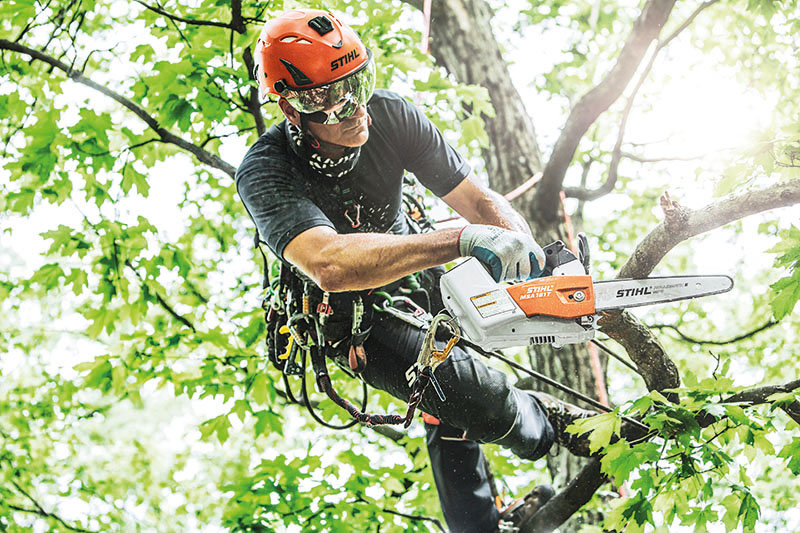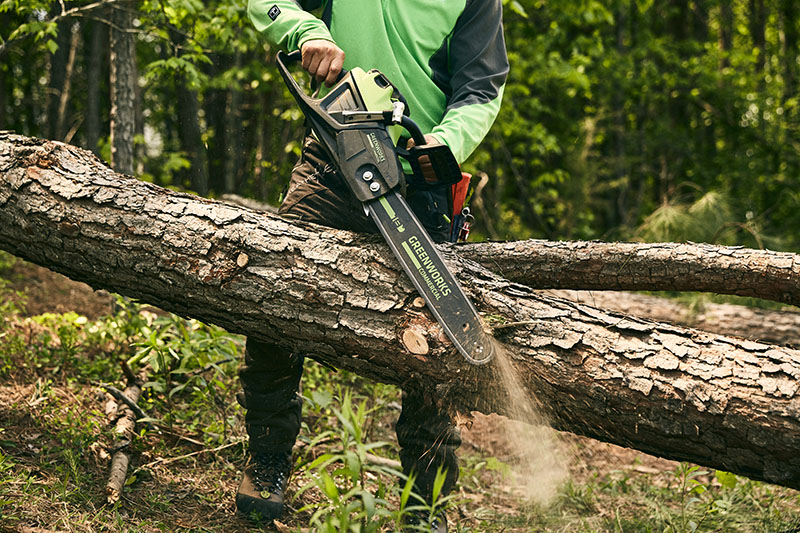Checking in on Battery-powered Chain Saws
Experts discuss the state of the technology and when might they replace gas-powered options.

Lawmakers across the country are taking steps to help reduce carbon emissions by banning the sale of gas-powered lawn-care equipment. Those who support the efforts often justify the ban by citing research by the Environmental Protection Agency showing that gas-powered lawnmowers, leaf blowers, and chain saws make up about 5% of the nation’s air pollution. States like California and New York will enact such prohibitions in 2024 and 2025, respectively, while other states are still legislating similar measures. In early February, Minnesota became the latest example.
In response, green-industry groups often express concern about the cost of replacing equipment, deficiencies in the technology and the timeline for the transition, but in some areas, those issues largely fall on deaf ears. So, with dwindling timelines and model legislation making its way into statehouses across the country, it raises the question: What is the current state of electric lawn care equipment, specifically battery-powered chain saws?
Bias against battery-powered chain saws
If you type “battery v gas chain saws” into a search engine, you’ll find a nearly infinite supply of articles and videos on the subject. Most people conclude that gas-powered chain saws come out on top because they deliver a better performance. They tend to cut better for longer periods of time.

But if you ask experts like Mark Chisholm, he’ll tell you that there’s more to consider than just performance. Chisholm has won several awards and accolades for his work in the world of arboriculture. He’s a third-generation International Society of Arboriculture certified arborist working with his family-owned Aspen Tree Expert Company in New Jersey. He’s also a consultant and spokesman for equipment maker Stihl.
Chisholm explains that there’s a bias against electric chain saws because early iterations had problems. For instance, some didn’t perform well in the rain and others weren’t terribly rugged. Negative opinions have lingered because of word-of-mouth reviews and online chatter rather than personal experiences. However, technology has improved significantly in a few short years due to demand and societal forces.

“Year over year, it’s amazing what’s going on,” Chisholm says and explains that he uses electric trimmers and chain saws for a variety of tasks on the job site. He says he especially loves the ergonomics of his electric saws. “It just feels nice to be able to grab the saw… and go right to work,” he says. “It’s just squeeze and go, and it’s just so convenient and comfortable. I use it on a lot of pruning jobs in particular and some removal jobs as well.”
They’re convenient, but…
When asked to describe the benefits of electric chain saws, Chisholm lingers on the idea of convenience. Compared to gas-operated chain saws, electric chain saws start with a push-button rather than a pull starter, they require very little maintenance and they produce no exhaust fumes. Plus, they’re quieter, so it’s much easier to communicate on the job site. “They’re just easier,” he says.

As for the power deferential, Chisholm explains that it’s not that battery-powered chain saws are underpowered, it’s that the batteries in their current state can’t produce enough juice to fuel the chain saw for really aggressive jobs—at least, not unless you “strap on a battery the size of a backpack.”
Even though Chisholm praises battery-powered chain saws, he calls the 2024 and 2025 goals “lofty” and says the technology might not catch up to the initiative. “When a guy like me might have to cut a four-foot diameter tree off a house during a storm, you just can’t do it with a battery-powered saw yet,” he says.
Understanding the cost
To be clear, though, it’s not that there’s something lacking in chain- saw battery technology, but rather, equipment makers have to strike the right “balance between cost and technology,” explains Per Kvarby, vice president of product management at Greenworks, an electric lawn equipment maker.

“Can we put together a chain saw that delivers the power of a 90cc gas saw? Yes, of course, we can. Is someone willing to buy it? No, it’s going to be excessively expensive, so there’s that balance of having the technology available at a good price that someone feels comfortable with buying,” Kvarby says.
If you compare the price of battery-powered chain saws with their gas-powered equivalents, you’ll notice that the battery-powered saws typically cost less. That’s one of the reasons experts like Chisolm recommend them for homeowners. But if you want to use them for professional jobs, there’s a little more to consider.
Because professionals use their chain saws more often, they’ll also need more batteries and maybe even more chargers. These items make upfront costs for transitioning to battery-powered more expensive. But there’s a caveat, as Kvarby points out. You’ll save money in the long run because you won’t have to pay for oil, gas and a variety of maintenance.

Battery-powered chain saws becoming the norm
Still, the question remains: When will battery-powered chain saw technology reach its potential? Kvarby explains this year might not be the year—even though Greenworks will release “very powerful and exciting” battery-powered saws—but he predicts major changes happening within the next five years.
“We could possibly see the complete demise of gas-powered chain saws at all levels,” Kvarby says. “I think technology is moving forward so incredibly quickly that five years from now, there probably won’t be a need for gas-powered saws anywhere, for any application and for any purpose.”

Kvarby argues that the change will happen because of supply and demand. When there’s more demand, companies will create a bigger supply, and things get less expensive to make when you have to make more of them. Somewhere along the way, companies will be able to release better batteries at a rate customers are comfortable with paying.
“When the first Tesla came out, it was $100,000 and now you have Model 3, which is $30,000, and batteries in lawn and garden tree care are taking the same journey,” Kvarby says. “It will start out pricey, but as more people, more volume, as the business grows, the pricing will come down.”
About the Author
Daniel Terrill is a writer, editor, and journalist best known for his work covering the gun and outdoor industries. His work has appeared in a variety of niche news publications like Task & Purpose, Android Police, Guns.com, and more. He lives in suburban Chicago.
